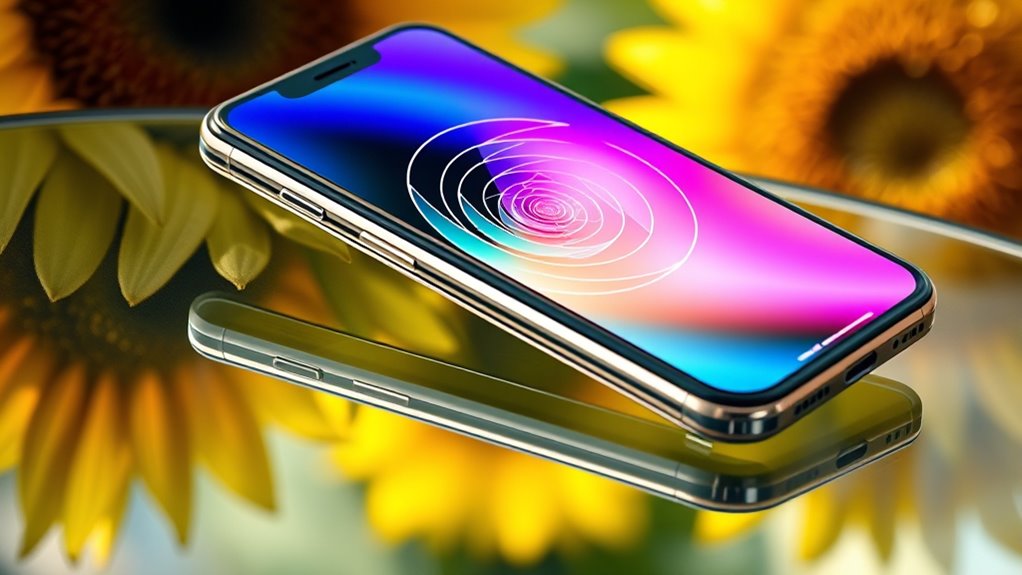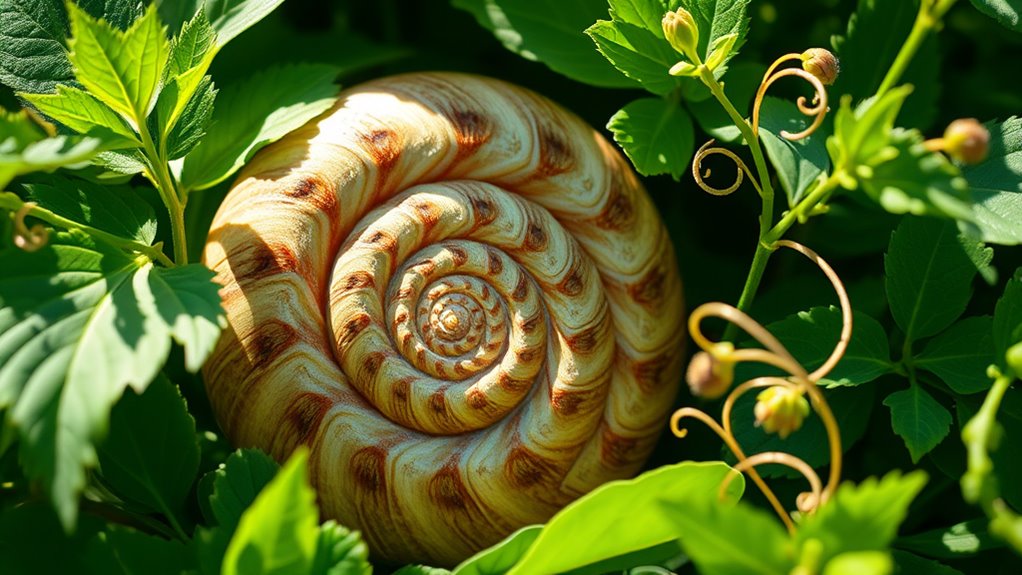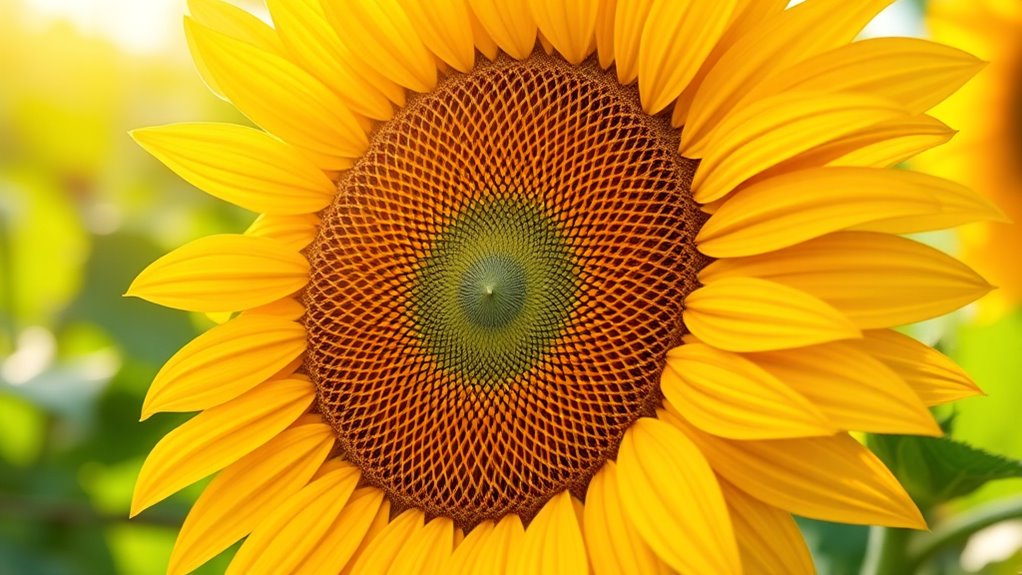The Golden Ratio, approximately 1.618, is a fascinating mathematical constant that shows up everywhere—from natural patterns like seashells and sunflower seeds to art and architecture for its sense of harmony. It’s rooted in unique properties, linking to Fibonacci numbers and natural growth. Its universal appeal influences design and aesthetic preference, revealing a deep connection between math, nature, and beauty. To uncover how this mysterious ratio shapes our world, explore further insights ahead.
Key Takeaways
- The Golden Ratio (ϕ ≈ 1.618) is an irrational number defined by a unique proportional relationship, rooted in recursive and algebraic properties.
- It appears naturally in patterns like sunflower seeds, seashells, and plant arrangements, reflecting efficient growth and harmony.
- Artists and architects historically used the Golden Ratio to create aesthetically pleasing compositions and structural designs.
- Modern fields like UI/UX design and architecture incorporate ϕ to enhance visual harmony and functional aesthetics.
- Despite myths, the Golden Ratio signifies mathematical beauty and natural harmony but does not guarantee universal perfection.
The Mathematical Foundations of the Golden Ratio

The Golden Ratio, often symbolized by the Greek letter phi (φ), has a precise mathematical definition rooted in ratios and proportions. You can understand it through algebraic derivations, where solving quadratic equations reveals that φ equals (1 + √5)/2. This unique value satisfies the property that dividing a line into two parts, with the whole length divided by the longer part, equals the longer part divided by the shorter part. Geometric constructions also illustrate the ratio, using tools like a compass and straightedge to create segments that embody φ’s proportions. These methods demonstrate how the ratio emerges naturally from simple geometric steps and algebraic formulas, forming the core mathematical foundation that underpins the Golden Ratio’s intriguing properties. Additionally, the static contrast ratios used in projectors help ensure consistent performance and accurate visualization of these proportions in digital displays.
The Golden Ratio in Historical Art and Architecture

Throughout history, artists and architects have intentionally incorporated the Golden Ratio into their works, believing it creates harmony and aesthetic appeal. Medieval manuscripts often feature layouts and decorative elements aligned with the ratio, enhancing visual balance. Ancient mosaics, such as those in Byzantine churches, display proportions that reflect the Golden Ratio, guiding the viewer’s eye and creating a sense of coherence. These examples demonstrate how the ratio was used to achieve beauty and order long before modern mathematics. By applying the Golden Ratio, creators sought to evoke harmony, proportion, and divine perfection. Its presence in diverse historical artworks reveals a universal desire to capture natural beauty and balance through mathematical principles. This enduring use underscores the ratio’s timeless influence on art and architecture.
Natural Phenomena Exhibiting the Golden Ratio

Many natural patterns and structures seem to follow the Golden Ratio, revealing its deep connection to the world around us. You can observe this in flower symmetry, where the arrangement of petals and seeds often aligns with Fibonacci numbers, creating a pleasing balance. Seashell spirals are another striking example; their logarithmic curves grow proportionally, adhering to the Golden Ratio as they expand. These patterns aren’t random—they reflect efficient growth and ideal space utilization in nature. By recognizing these phenomena, you see how the Golden Ratio influences natural beauty and structure. From the delicate symmetry of a flower to the elegant spiral of a seashell, this ratio underpins many of nature’s most mesmerizing designs. It highlights nature’s intrinsic harmony and mathematical elegance. natural patterns often exhibit this ratio, demonstrating its fundamental role in shaping the physical world around us.
The Golden Ratio in Modern Design and Technology

In modern design and technology, the golden ratio influences UI and UX aesthetics, creating visually appealing and intuitive interfaces. Architects incorporate it into innovative structures, enhancing both form and function. Digital artists also use the ratio to craft engaging visuals and trends that resonate with viewers. Additionally, understanding the role of attention in creative practice can help designers and artists develop more focused and impactful works.
UI/UX Aesthetics
Have you ever noticed how some designs feel naturally pleasing and balanced? That’s often due to the Golden Ratio’s influence on UI/UX aesthetics. When applied to color harmony, it creates a visual flow that guides your eye effortlessly. Similarly, in typography pairing, the ratio helps balance font sizes and styles, enhancing readability and elegance. Here’s a simple breakdown:
| Aspect | Application | Effect |
|---|---|---|
| Color harmony | Using ratios to select complementary shades | Creates cohesive visuals |
| Typography pairing | Balancing heading and body font sizes | Improves clarity and flow |
| Layout composition | Structuring elements with Golden Ratio | Achieves visual harmony |
Additionally, understanding regional legal resources can inform how designers approach different cultural aesthetics, ensuring the visual experience resonates universally.
Architectural Innovations
Ever wondered how the Golden Ratio continues to shape modern architecture and technology? You’ll see its influence in innovative designs that prioritize sustainable materials and efficient urban planning. Architects incorporate the ratio to create visually pleasing structures that blend form and function seamlessly. In urban planning, the Golden Ratio guides the layout of public spaces, ensuring harmony and balance within cityscapes. Using sustainable materials, designers achieve eco-friendly buildings that reflect natural proportions, reducing environmental impact. These innovations help cities grow intelligently, emphasizing aesthetic appeal and sustainability. The use of natural proportions in design not only enhances visual harmony but also promotes environmental consciousness. The Golden Ratio acts as a blueprint for modern design, inspiring solutions that are both beautiful and practical. As technology advances, its principles remain an essential tool for shaping the future of architecture and urban development.
Digital Art Trends
Digital artists and designers are increasingly applying the Golden Ratio to create visually compelling and harmonious works. With AI generated art and algorithmic design, the ratio guides the composition, making digital creations more balanced and aesthetically pleasing. Modern tools leverage these mathematical principles to produce innovative visuals effortlessly. You’ll notice the Golden Ratio shaping website layouts, logo designs, and virtual environments, enhancing user experience and visual appeal. AI algorithms analyze countless patterns to integrate the ratio seamlessly, saving time and boosting creativity. This trend pushes boundaries in digital art, blending technology with timeless aesthetics. Additionally, understanding the underlying mathematical concepts, such as the Golden Ratio, helps creators develop more intentional and appealing designs.
Mathematical Properties and Unique Features of ϕ

The mathematical properties of the golden ratio, often represented by the symbol ϕ, make it uniquely fascinating among irrational numbers. Its algebraic properties include satisfying the equation ϕ² = ϕ + 1, which reveals its recursive nature. Its irrationality proofs show that ϕ cannot be expressed as a simple fraction, highlighting its non-repeating decimal expansion. One remarkable feature is that ϕ equals (1 + √5) / 2, connecting it directly to the square root of 5. Here’s a quick overview:
| Property | Description | Significance |
|---|---|---|
| Algebraic equation | ϕ² = ϕ + 1 | Defines ϕ mathematically |
| Irrationality proof | Can’t be expressed as a ratio | Uniqueness among irrationals |
| Continued fraction form | [1; 1, 1, 1, …] | Reflects its infinite nature |
| Connection to √5 | ϕ = (1 + √5)/2 | Links to quadratic solutions |
The algebraic equation ϕ² = ϕ + 1 demonstrates its recursive nature, which is fundamental to understanding its mathematical significance.
The Role of the Golden Ratio in Aesthetic Perception

The golden ratio plays a significant role in shaping our aesthetic perceptions, often appearing in art, architecture, and nature to evoke a sense of harmony and balance. When you observe compositions based on this ratio, you’ll notice how they naturally feel pleasing and well-proportioned. It influences how we perceive color harmony, creating palettes that feel balanced and engaging. The golden ratio also guides visual balance, making images or structures appear more stable and appealing. You can spot its subtle presence in famous artworks and architectural marvels, enhancing their beauty. Recognizing these patterns helps you understand why certain designs resonate with you on an instinctive level. By appreciating the golden ratio, you gain insight into the subconscious principles that shape aesthetic appeal across various forms. Additionally, understanding industry trends related to design principles can deepen your appreciation for how these ratios are applied across different creative fields.
The Connection Between the Golden Ratio and the Fibonacci Sequence

You’ll see that the Fibonacci sequence starts with simple numbers that grow quickly, but their ratios approach the Golden Ratio over time. This pattern highlights a natural connection between the sequence’s growth and the ratio’s appearance in nature and art. Understanding this link reveals how math shapes both the world around us and our aesthetic preferences.
Fibonacci Sequence Fundamentals
Fibonacci sequences reveal a fascinating link to the golden ratio through the way their numbers grow. As the sequence progresses, each number is the sum of the two preceding ones, demonstrating recursive patterning. This recursive process creates a pattern that appears repeatedly in nature. You’ll notice Fibonacci numbers in sunflower seed arrangements, pinecones, and shells, where spiral growth is prevalent. The sequence also forms the basis for many natural structures due to its efficiency and harmony. Understanding these fundamentals helps you grasp how simple recursive rules can produce complex, beautiful patterns. This connection highlights the elegance of mathematics in nature’s design, revealing that the Fibonacci sequence isn’t just a mathematical curiosity but a fundamental pattern underpinning the natural world. Additionally, the mathematical principles behind these sequences explain why they are so prevalent in natural formations.
Ratio Convergence Pattern
As the Fibonacci sequence progresses, the ratio of consecutive numbers begins to approach a specific constant, revealing a remarkable connection to the golden ratio. This ratio convergence demonstrates how pattern development in the sequence reflects a fundamental mathematical harmony. Early on, the ratios fluctuate greatly, but as numbers grow larger, they stabilize around 1.61803, the golden ratio. This pattern development shows a natural tendency toward this constant. Additionally, understanding noise levels of modern heat pumps can improve comfort in buildings relying on such systems. Below is a table illustrating this convergence:
| Fibonacci Pair | Ratio |
|---|---|
| 3 / 2 | 1.5 |
| 8 / 5 | 1.6 |
| 21 / 13 | 1.6154 |
You’ll see the ratios get closer and closer to 1.61803, emphasizing the ratio convergence characteristic of the Fibonacci sequence.
Natural and Artistic Links
The pattern of ratio convergence isn’t just a mathematical curiosity; it also reveals a deep connection to natural and artistic forms. You’ll notice the Fibonacci sequence appears in botanical patterns, like sunflower spirals and pinecones, reflecting how nature grows efficiently. In music, composers have used the Fibonacci numbers to structure musical compositions, creating harmony and balance that resonate with listeners. This link between the sequence and real-world patterns demonstrates how the golden ratio influences both natural beauty and artistic expression. By understanding this connection, you see how nature’s design principles inspire human creativity. Whether in the arrangement of petals or the structure of a symphony, the Fibonacci sequence beautifully bridges mathematics with the world around you. Understanding the sequence’s significance further highlights its pervasive role across diverse fields.
Misconceptions and Myths Surrounding the Golden Ratio

Many people believe that the Golden Ratio is a mysterious secret behind all beautiful designs, but this is largely a myth. Myth debunking reveals that many claims about ϕ’s mystical powers are exaggerated or false. The misconception origins often stem from misinterpretations of historical texts or selective use of examples. For instance, some say the ratio appears in famous artworks or architecture intentionally, but evidence shows many of these connections are overstated or coincidental. You should know that while ϕ has mathematical beauty and natural relevance, it doesn’t guarantee aesthetic perfection or divine inspiration. Believing it does can lead to overestimating its influence. Additionally, understanding how misinterpretations of historical texts have contributed to these myths can help clarify the true role of the ratio. Recognizing these misconceptions helps you appreciate the ratio’s true role without falling for unfounded myths.
Exploring the Universal Appeal and Future Potential of ϕ

While some see the Golden Ratio as a mysterious symbol of aesthetic perfection, its real appeal lies in its universal presence across nature, art, and science. You can explore how ϕ influences cutting-edge fields like quantum computing, where its mathematical properties help optimize algorithms and data structures. Additionally, ϕ reveals fascinating patterns in linguistic structures, guiding researchers to uncover hidden connections in language evolution. Its appeal continues to grow because it bridges disciplines, offering insights into complex systems and aesthetic harmony. As technology advances, the future potential of ϕ expands—potentially shaping innovations in artificial intelligence, pattern recognition, and even understanding the fundamental order of the universe. The mathematical properties of ϕ underpin its role in various scientific and artistic domains, and its ongoing study promises new discoveries that could transform multiple fields. The Golden Ratio’s universal appeal promises new discoveries, inspiring both scientists and artists alike.
Frequently Asked Questions
How Does the Golden Ratio Influence Human Perception of Beauty?
You might notice that facial symmetry and visual harmony often influence your perception of beauty. The golden ratio plays a role here, as it helps explain why certain proportions are naturally appealing to you. When features align with these ratios, your brain perceives the face as more balanced and aesthetically pleasing. This subconscious recognition of the golden ratio enhances your appreciation of beauty through perceived harmony and proportion.
Are There Natural Exceptions Where the Golden Ratio Does Not Appear?
Think the universe is perfectly symmetrical? Think again! Biological anomalies and planetary formations often defy the golden ratio, proving nature’s sense of humor. You’ll find irregularities in DNA structures or bizarre planetary shapes that ignore this sacred proportion. So, no, the golden ratio isn’t a universal rule—it’s more like a stylish suggestion that nature occasionally forgets to follow, reminding us that chaos is just as beautiful as order.
Can the Golden Ratio Be Applied to Optimize Modern Architectural Design?
You can apply the golden ratio to optimize building proportions and enhance facade aesthetics. By using it as a guideline, you create visually appealing and harmonious designs that attract attention and feel balanced. Incorporating the ratio helps you develop structures with pleasing proportions, making architectural elements more engaging. While not mandatory, leveraging the golden ratio can elevate your modern architectural projects, balancing functionality with aesthetic appeal.
What Are the Psychological Reasons Behind the Golden Ratio’S Aesthetic Appeal?
You’re curious about why the golden ratio feels so aesthetically pleasing. It taps into your sense of visual harmony, creating a balanced and natural look. Your brain also exhibits a cognitive bias toward patterns that are simple and proportionate, making the golden ratio subconsciously attractive. This blend of innate preference and harmony explains its enduring appeal, as your mind naturally gravitates toward these pleasing proportions in art, design, and nature.
Is the Golden Ratio Truly Universal Across All Cultures and Civilizations?
You might wonder if the golden ratio truly spans all cultures and civilizations. Notably, while many historical perspectives highlight its presence in art and architecture worldwide, cultural variations influence aesthetic preferences. It appears that, although some societies recognize this ratio, others prioritize different standards of beauty. So, the golden ratio isn’t universally embraced, but rather a fascinating example of how beauty standards evolve through diverse cultural lenses.
Conclusion
You’ve seen how the golden ratio appears everywhere—from ancient art to modern design—highlighting its timeless appeal. Did you know that around 61% of people find images or objects with the golden ratio more aesthetically pleasing? This statistic shows how deeply ingrained ϕ is in our perception of beauty. Embracing its mathematical elegance can inspire your creativity and appreciation for the natural and artistic worlds around you.





